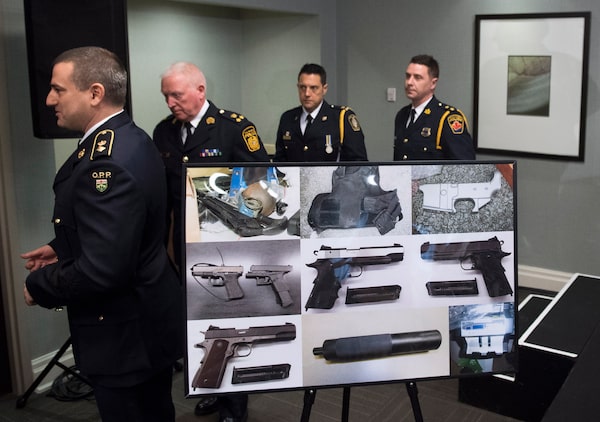
Police officers from different partner agencies leave after a press conference regarding the recent multi-jurisdiction investigation into trafficking of illegal firearms and illegal drugs in the Greater Toronto and Golden Horseshoe areas of Ontario in Vaughan, Ont., on Dec. 11, 2018.Nathan Denette/The Canadian Press
Police in the Greater Toronto Area say they have dismantled a major weapons trafficking operation responsible for manufacturing and selling at least 120 untraceable guns.
Twenty-three people are facing 156 charges in connection with an alleged crime ring that built and sold what are known as ghost guns – firearms without a serial number or other identifying markers.
The traffickers allegedly assembled legally purchased gun components into fully functional, illegal handguns, exploiting a grey area in national gun regulations that allows for the unchecked sale of certain firearms components.
“These are legally obtained parts that you can legally buy being put together to create these untraceable handguns,” said Superintendent Bryan MacKillop, director of the Ontario Provincial Police Organized Crime Enforcement Bureau, which led the joint investigation.
The joint investigation officially launched this year, but had its origins in 2016, when ghost guns began turning up on Toronto streets, a trend that soon spread across the region. In April, investigators initiated Project Renner, led by the OPP, with participation from police in Toronto, Hamilton, Barrie and the regions of Halton, Durham, Peel, London and Niagara.
Since then, the project team has seized 14 handguns, six long-guns and an array of prohibited accessories, including silencers, grenades, a stun gun and body armour. They also seized 1.2 kilograms of cocaine, 66 fentanyl tablets, $85,000 in cash, four vehicles and a residential property.
In all, police forces in the province have seized 50 illegally manufactured guns since January, 2017, but forensic work is continuing to determine whether they originated from the group targeted in Project Renner.
At a morning news conference on Tuesday, the OPP alleged that two of the accused – 47-year-old Bruce McKinnon from Rockwood, Ont., and 29-year-old Jon Rasmussen from Smithville, Ont. – manufactured at least 120 handguns. They each face multiple gun and gang charges.
Police said the guns have been linked to numerous crimes in the GTA, but could not divulge details while some of those cases remain under investigation or go through the courts.
Supt. MacKillop pegged the street value of the handguns at roughly $2,500 each and said the 23 accused, none of whom were licensed gun-owners, did not require a complex machine shop or foundry to assemble the domestically purchased parts.
"This is nothing to do with legal gun ownership," said Detective Inspector Brad Nunn, a member of the OPP Provincial Weapons Enforcement Unit.
News of the charges comes as the federal government is considering a range of measures to tackle rising gun violence, including an all-out ban on handguns and assault-style rifles. A firearms bill currently before the Senate includes provisions for expanded background checks, mandatory record-keeping at gun businesses and tighter restrictions on transporting firearms – but nothing targeting unmarked gun parts.
A report from the B.C. Task Force on Illegal Guns last year called for a prohibition on access to unmarked gun parts and detailed how criminals can assemble illegal guns from components. The report states that the parts are widely available from sporting goods stores and the internet in the form of unregulated kits that include tools to assemble the pieces into a fully functional gun.
“Some legislative body has to take a serious look at how these unregulated parts are being used illegally,” Det. Nunn said.
Wes Winkel, president of the Canadian Sporting Arms and Ammunition Association and owner of Ellwood Epps Sporting Goods in Orillia, Ont., said many gun components are generic springs, pins and screws that would be virtually impossible to regulate. “There is no way to control springs and screws,” he said. “You simply can’t control every piece of metal in the world.”
He said that the main housing, or receiver, component of most guns is closely regulated by law, but some manufacturers have devised ways to skirt regulations with receivers called 80-per-cent guns, fabricated specifically to fall outside the legal threshold for a firearm. With a few minor modifications, and a little help from numerous online resources, these 80-per-cent guns can be turned into functional firearms with relative ease.
“To buy an 80-per-cent gun is legal, as easy as buying gear for your bicycle,” Mr. Winkel said. “Most reputable stores, like mine, don’t sell them because they cheat the spirit of the law.”
 Patrick White
Patrick White